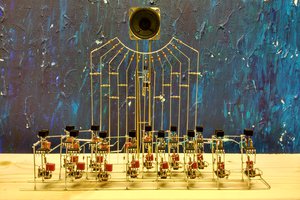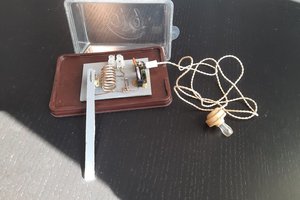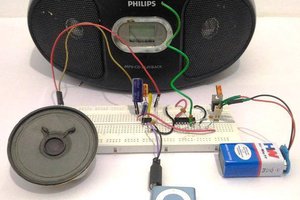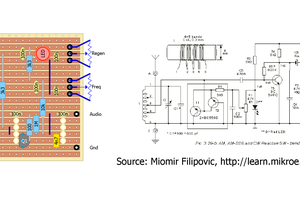Shortwave Crystal Radio - A blast from my past
Building and tinkering with crystal radios goes back to my childhood of the late 1960's and coming round again.
Building and tinkering with crystal radios goes back to my childhood of the late 1960's and coming round again.
To make the experience fit your profile, pick a username and tell us what interests you.
We found and based on your interests.
July 15, 2023 - This little hay wired receiver is better than I was expecting. Between July 5 and today I have copied on 40M CW, 61 stations from States all along the east coast from Florida to Maine and west to Indiana with the best being PY7XC in Brazil. Remember that this receiver is just a crystal receiver with a Local Oscillator loose coupled and a lot of audio amplification and no RF gain stages at all. The antenna is just a 35 foot wire and NO ground connected. The CW filter on the proto board helps a lot as well as the wave trap on the antenna input. I also made a slight improvement by adding a Bogan T725 audio transformer between the detector and the CW filter. Direct Conversion at its most sloppy but it works so well.
July 12, 2023 - A very active Wednesday morning on 40M CW. I think this is due to the Minitest 40 contest as usually 40M at mid morning is usually dead when it comes to receiving on my modified crystal radio. Note that I have added a CW filter that peaks at 700Hz but is still a bit broad but it does reduce the highs and lows nicely. I have a slight hum that I am working on. I need a good ground rod but can not buy one until next week, otherwise I am picking up power line hum through the various exposed wires in my lab ;-)
July 5, 2023
The last post mentioned adding a Wave Stop filter to the antenna input. Basic cap and inductor in parallel inserted in series with the antenna as pictured in the upper left of the wood chassis. Tune the cap to trap or stop a unwanted signal from reaching the main tuner and detector.
July 5, 2023
Here is a receiver that I decided to build just this week after I had first used this same circuit years ago. It is about as simple as you can get and still receive decent CW on either the 80M or 40M bands. If SW AM stations bleed in then using T50-2 toroids for the coils increases the Q and helps a lot.
A AM shortwave broadcast from Radio Havana was getting past the tuner at night so I added a simple wave trap to the antenna line. So far so good. Next will be a audio filter to narrow the audio bandwidth a bit to make listening to CW easier when a lot of signals are close to each other.
The circuit is from the following site and I highly recommend giving it a try. https://www.qsl.net/kc6wdk/QRP/
Back a few years ago I stepped up my game and wired up a DSB double sideband tranceiver that actually worked quite well and I made daily net contacts on 75 meters for almost a year with it. The circuit is the Wee Willy and can be found online. Output was about 1 watt.
Well, you could call the oscillator I am using a BFO or a VFO ( Actually both ). Depends on how you look at it. I have used this circuit and actual build for many years without any problems. Not really state of today's art and it sure is not stable compared to a lot of other circuits out there but it works with just a hand full of parts and never quits.
Here is the circuit followed by the web page link.
Well, this is a cleaned up setup. At the rear is a perf board crystal controlled oscillator that can be modulated by the laptop if needed and is loose coupled to the radio. The circuit on the left is the RF BFO and is also loose coupled via the slug tuned coil. On the right are a few of the crystals used on the signal generator. Not shown is the small earphone I use to listen to the audio output but that just clips onto the radio. The BFO is varicap tuned on its front panel and has a 15 KHz range from about 7.03 to 7.045 MHz.
The BFO circuit is at least 15 years old and was part of a much older crystal radio receiver for 40M CW. In this case the crystal radio becomes a very basic Direct Conversion receiver. Still no RF or AF amplification but I might add a LM386 audio amp for speaker listening.
Well, I have finished the construction of the radio and since I have yet to put up a decent antenna, I want to at least test to see if the tuned circuit and detector will sniff out a RF source of some kind.
I do have a simple crystal test circuit wired up on perf board from years ago and if I have it oscillate at say 7.04 MHZ and modulate the RF, I should be able to hear the modulation in the earphone.
Going old school and brute force method and modulate the Oscillator by placing a small audio transformer in the 9 volt power lead then feed the transformer with a audio source from the laptop. Not the best way to do it but it is what it is :-)
Two Hours Later.......
Success, I was able to generate a modulated RF signal at 6, 7 and 11.155 MHZ and calibrate a rough dial. The tuning was fairly sharp and the variable coupler works like it should as well :-)
Create an account to leave a comment. Already have an account? Log In.
Hello, nice work! For some reason, recently, after a few late night beers, I ordered a crystal radio kit from some place called UnitedNuclear in the USA. Of course, next day, I realised that there are no longer any stations broadcasting on MW in Ireland. So I wondered about converting it for SW. Then I found your excellent project.
A couple of questions, what length of Antenna did you use for your Crystal radio? And what did you use for an earth?
Cheers,
Con
I was wondering if germanium has been surpassed by shottky small-signal diodes in terms of low forward voltage, has anyone tried a 1N5817 or similar? Or is that considered too "high tech" for a crystal radio?
I have read of others using a 1N5817 or type with good results but I have not tried one yet. I still mess with Germanium but never too high tech to try other diodes or crystals :-) You could also forward bias the diode with a small voltage to help nudge it into conduction much like with a Carborundum detector. No rules so try anything :-D
Cheers I might give it a go - I'll add one to my next RS order. I still have a stash of old dual-gang tuning caps like yours lurking somewhere, that I scavenged in the '70's from old valve radios. For the LO though I might try running a PLL synth off a 26MHz OCXO - stable to 50ppb so no drift there....
All sounds like fun Adam, Yeah, all my caps are from the 70's and back to the 20's so I have a lot of "junk" to play with :-) For me simple is better but sometimes even simple can use a little help ;-)
This is the stuff that got me into ham radio many years ago and I still love it :-D
I'm a ham, too. Only tech class, and I spend most of my time on VHF repeaters. What are your favorite bands?
Been a ham since 1974 and advanced class ( those are no longer issued ). I prefer 80 and 40 meters QRP CW but I also have a homebrew DSB transceiver shelved away ( I'll post a short vid of that ) :-) Have not been on the air for several years but that is about to change :-)
*VERY* nice, Doc :D here, this might also tickle your fancy... ;)
Thanks and the FM crystal radio looks very interesting :-)
I built a crystal set once and was stunned when it actually worked! It was a nearby station and the audio was incredibly weak, but what a thrill to hear that signal.
As a kid, I started out with those plastic sets made in Japan and there were a few strong stations in Miami that always boomed in but later I learned to build with selectivity in mind and really started to pull them in. It is just as fun now as then :-)
My first AM crystal radio used a germanium diode from an early 60s computer and headphones from WW II or shortly thereafter. That was 45 years ago :-)
45 years has been a while back but the fun and thrill continues today :-)
Unfortunately, AM radio stations are no more (at least not in this part of central Europe). I just got an old AM radio from the basement and scanned from 540 through 1600 kHz: I received many more stations than in the old days, in many languages (Russian, Arabic and some that I didn't recognize), some local music (Turkish?) but all were very weak. It's not clear if a crystal radio would work - maybe I should try it :-)
With reduced local AM stations I would take a listen at night. A crystal set should pickup some night signals and you could always add a small amp to play through a speaker if you want.
Good idea. Maybe I'll try that "TL431 as an amplifier" hack:
http://vu2ppp.com/_simple_audio_amplifier_using_tl431
I have never used a TL431. looks interesting. I have a few LM386 here so I might wire up a amp that way.
I always saw the TL431 applied as a 2.5V "Z-diode like" component , but it's in fact an op-amp with a reference. Using it as an amplifier in a really small package is rather cool.
Become a member to follow this project and never miss any updates

 MaBe42
MaBe42
 Andrea Console
Andrea Console

 agp.cooper
agp.cooper
I am curious, do they still make Variable Capacitors like that one in your project ?